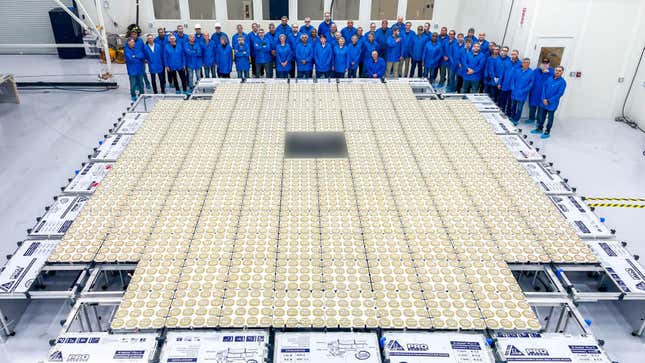
A huge satellite is about to take flight, spreading its giant antenna array to potentially block astronomers’ views of the cosmos. AST SpaceMobile’s BlueWalker 3 is scheduled for launch on Saturday to test the company’s broadband network technology, but the prototype satellite is extremely bright and could interfere with celestial observations.
BlueWalker is scheduled to ride to low Earth orbit aboard SpaceX’s Falcon 9 rocket at 7:51 p.m. ET from the Kennedy Space Center in Florida. Once in low Earth orbit, the satellite will test out the Texas-based company’s ability to directly beam internet connectivity from space to people’s cellphones. The Chairman and CEO of AST SpaceMobile Abel Avellan recently boasted on Twitter, “Made in TX— size matters!” when referring to the satellite. And indeed it does, as this bad boy sports a 693 square foot array of antennas (64 square meters) that will unfold in space. With its antenna fully unfurled, the satellite is expected to be among the brightest objects in the night sky, according to Sky and Telescope.
As it points towards Earth, the satellite’s giant array will reflect sunlight back to our planet, potentially causing bright streaks across astronomical images and interfering with scientific data. Even worse is that if the test satellite succeeds in its mission, the company could send more than 100 of its satellites to orbit by the end of 2024 to build out a full internet constellation. The operational satellites, which are to be named BlueBirds, could cause even more interference as they are expected to be of similar size to BlueWalker 3.
Astronomers have expressed concern over the satellite’s brightness as it joins the hoards of commercial satellite constellations currently being built in low Earth orbit. From the location of Rubin Observatory on Cerro Pachon in Chile, the BlueWalker satellite will be as bright as the star Vega near zenith in twilight, according to Connie Walker, an astronomer at the National Science Foundation’s (NSF) NOIRLab. “These new satellites are expected to saturate Rubin observations,” Walker told Gizmodo in an email.
In an effort to understand the extent of this threat, NSF’s NOIRLab and the International Astronomical Union’s (IAU) Centre for the Protection of the Dark and Quiet Sky from Satellite Constellation Interference have called on astronomers from around the world to take brightness observations of the satellite once it’s in orbit. “[Low Earth orbit satellites] disproportionately affect science programs that require twilight observations, such as searches for Earth-threatening asteroids and comets, outer Solar System objects, and visible-light counterparts of fleeting gravitational-wave sources,” NSF wrote in a report.
BlueWalker is launching to space along with 60 of SpaceX’s Starlink satellites, which have already caused disruption of astronomical observations. Elon Musk’s private space company is seeking to launch a whopping 42,000 satellites to low Earth orbit to build a broadband internet megaconstellation. Although SpaceX has only received approval for 12,000 satellites by the Federal Communications Commission thus far. But the company has been in talks with IAU to figure out ways to dim the brightness of their satellites so that they don’t interfere with images of the cosmos.
The advancement in technology brings on an exciting era for our connectivity, so hopefully it doesn’t come at the cost of our ability to stare at celestial objects and gather valuable data about the universe.
More: SpaceX Launches 3,000th Starlink Satellite as Elon’s Internet Constellation Continues to Grow